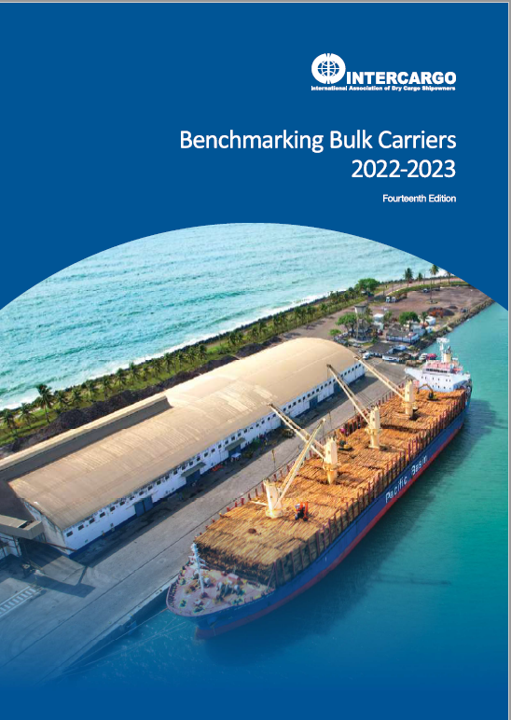The INTERCARGO “Benchmarking Bulk Carriers” 2022-2023 report has been published and this year will be in electronic format only.
Members may view the report below or download the attached (.pdf) file (login required).
Non-members may order the report from the Secretariat at info@intercargo.org or
for sales in Greece the report may be ordered here.
Prices are GBP 60.00 for the electronic version and GBP 75.00 for hardcopy.
Foreword / Executive Summary
It is now fast approaching 18 months since the Russian invasion of Ukraine left the world in a precarious situation with regard to grain and fertiliser shipments from key Black Sea ports.
In recognition of the critical importance of global food security, and its significant dependence on the supply of grain and other foodstuffs produced in the region the Joint Coordination Centre for the Black Sea Grain Initiative was established with its mission to allow ships to safely export grain, other foodstuffs, fertilizers, including ammonia, from Ukraine via a maritime humanitarian corridor.
This initiative supported by Ukraine, Turkey and Russia under the auspices of the United Nations has continued to allow the flow of these commodities at least until May 2023 when it is hoped the initiative will be renewed with the consent of all parties. INTERCARGO continues to make representation to the regulatory authorities concerning the uncertainty of safe navigation in the Black Sea region and the importance of keeping supply lines open for humanitarian reasons above any commercial matters.
We started 2023 by introducing a new membership fee structure which aims to increase the membership in terms of both numbers of ships registered but also bringing about an increase in registered deadweight tonnes. These increases will give INTERCARGO additional strength and a louder voice at the various international fora attended by the secretariat at which we represent the membership. This not insignificant change has, so far, been seamless and we are looking forward to working with our expanded membership during 2023 and for many years to come.
Whilst INTERCARGO fully supports the drive and the ambition to achieve zero emission shipping by 2050, it urges governments to adopt the necessary measures to accelerate R&D of zero-carbon technologies and expedite their deployment. The net-zero target will only be plausible if governments take the necessary action to achieve this at IMO and thus INTERCARGO supported the industry proposal for the establishment of an International Maritime Research and Development Board and an IMO Maritime Research Fund. This will need to be accompanied by a global levy based Market Based Measure to assist low and zero carbon fuels to become a competitive option for shipping, while the necessary policies on land to scale up green fuels production are essential.
The Association has been actively participating in the IMO deliberations and correspondence groups, expressing the views of its members on the measures being developed by IMO and the challenges associated with these measures, including both short term measures (EEXI,CII) and lifecycle GHG/carbon intensity guidelines for marine fuels.
The INTERCARGO badge of quality is widely recognised within the industry and as shown throughout this 14th edition of the benchmarking report, the efforts of our members in helping us to achieve our ambitious aims and objectives is to be commended. The present benchmarking report continues to evaluate the bulk carrier industry through numerous performance indicators, of which the highlights are as follows:
Global Fleet and Market Trends
The Baltic Dry Index (BDI) started 2022 at 2248 and then steadily climbed until reaching a high on May 16th of 3341. There followed a steady decrease until December 31st when the BDI ended the year at 1,380 an overall decrease of 868 from the beginning of the year. The downward trend in the BDI has continued into 2023 but has since picked up again reaching around 1600 in May and there is some optimism that the freight market will continue to improve. This will be driven by a recovery in the Chinese economy leading to an increase in the import of dry bulk commodities and also a possibility that economic activity in much of the rest of the word could begin picking up later this year. There is also the possibility that a larger volume of bulk carrier scrapping could retrain global fleet expansion.
Casualty reporting
Twenty-six bulk carriers over 10,000 dwt have been identified as total losses during the years 2013 to 2022. The average age of bulk carriers lost was 18.3 years and in total 2.1m DWT have been lost which equates to an average 212k DWT per year. Cargo shift and liquefaction remain the greatest contributors to loss of life and groundings remain the greatest causes of ship losses. 104 crew members lost their lives during the period, which in principle loss of one live is too many however, on the positive side as demonstrated by the tables and graphs in this section the trend in lives and vessels lost has been significantly improving year on year over the last 29 years which is something to be justifiably proud of.
Classification societies
The eleven leading Class Societies (IACS Members) “Class” over 95% of the bulk carrier market with an average dpi of 1.69 which is significantly better than the non IACS classed vessels with an average of 4.31.
Flag
In 2022 the global bulk carrier fleet was registered with 92 Flags, an increase of 4 since last year. Out of the 92, fifteen (15) have fleets of 100 bulk carriers or more accounting for just over 89% of the global bulker fleet.
Port State Control (PSC)
This chapter provides the statistics for the 9 regional PSC authorities and 2 national PSC regimes where, in terms of deficiencies per inspection (DPI), vessels calling at Australian ports continue to have the worst rate as determined by AMSA at 3.98 versus the average across all authorities of 1.55. In terms of detentions AMSA again is top of the list with a detention rate of 8.52% versus the average of 2.34%. The detention rates of bulk carriers in Black Sea, Paris and Tokyo MOU regions are all above the average rate. It is disappointing to note that all these parameters have seen an increase since last year’s report. Detention rates of bulk carriers in the Black Sea and Paris MoU regions continue to be amongst the highest but, as stated above, AMSA records the worst performance at almost 4 times the average for all regions and, for bulk carriers, over two times the rate for all ship types. The Tokyo MOU region recorded the most bulk carrier inspections at just under 11,000 with in 2nd place Paris and Vina Del Mar recording around 4,000 inspections each.
INTERCARGO – Entered Ships’ Performance
The tables and graphs in this chapter confirm that in 2022, INTERCARGO-entered vessels consistently bettered industry performance indicators in terms of both deficiencies and detentions, however the industry as a whole shows a steady increase in detention rates which while not a major cause for concern does show a disappointing trend upwards. Equally it is noted that deficiencies per inspection rates continue on a flat line.
Owners’ benchmarking
INTERCARGO-registered vessels continue to outperform the industry both in terms of Detention Rates (DTR) and Deficiencies per Inspection ratios (DPI).
Negative Performance Indicators (NPI)
Comparing 2022’s figures against the last three Benchmarking Reports it can be seen that hull/machinery damage remains the top NPI at around 31% of all recorded incidents while collisions retains the number 2 slot at almost 23% showing a slight reduction over the previous year. On a positive note, anchoring and mooring related NPI’s recorded 0% and cargo related NPI’s showed a marked decrease over the period.
Protection & Indemnity
The market share enjoyed by the Members of the International Group of P&I Clubs (IG) has seen a steady decline in the last three years remaining at around 80% while the market share of the non-IG Clubs has seen a steady increase and is now around 20% of the market. In performance terms measured in deficiencies per inspection (DPI) Members of the IG Clubs continue to record significantly less than the rest of the industry at DPI 1.45 versus 2.59. Gard maintains its top spot in 2022 maintaining around 11% of the market in terms of ship numbers but the award for the best performance in DPI terms goes to Britannia with a score of 1.15. Members and non-Members of our Association are encouraged to continue participating in INTERCARGO’s Reporting Schemes, including ‘Ship-Terminal Interface Experiences and Problems’ and ‘Safe Loading/Unloading at Anchorage’, as well as ‘Benchmarking crew injury frequency and lost time’.
Thank you for your continued support in all our endeavours to improve the safe operations of the dry bulk fleet globally.
The INTERCARGO secretariat
May 2023



